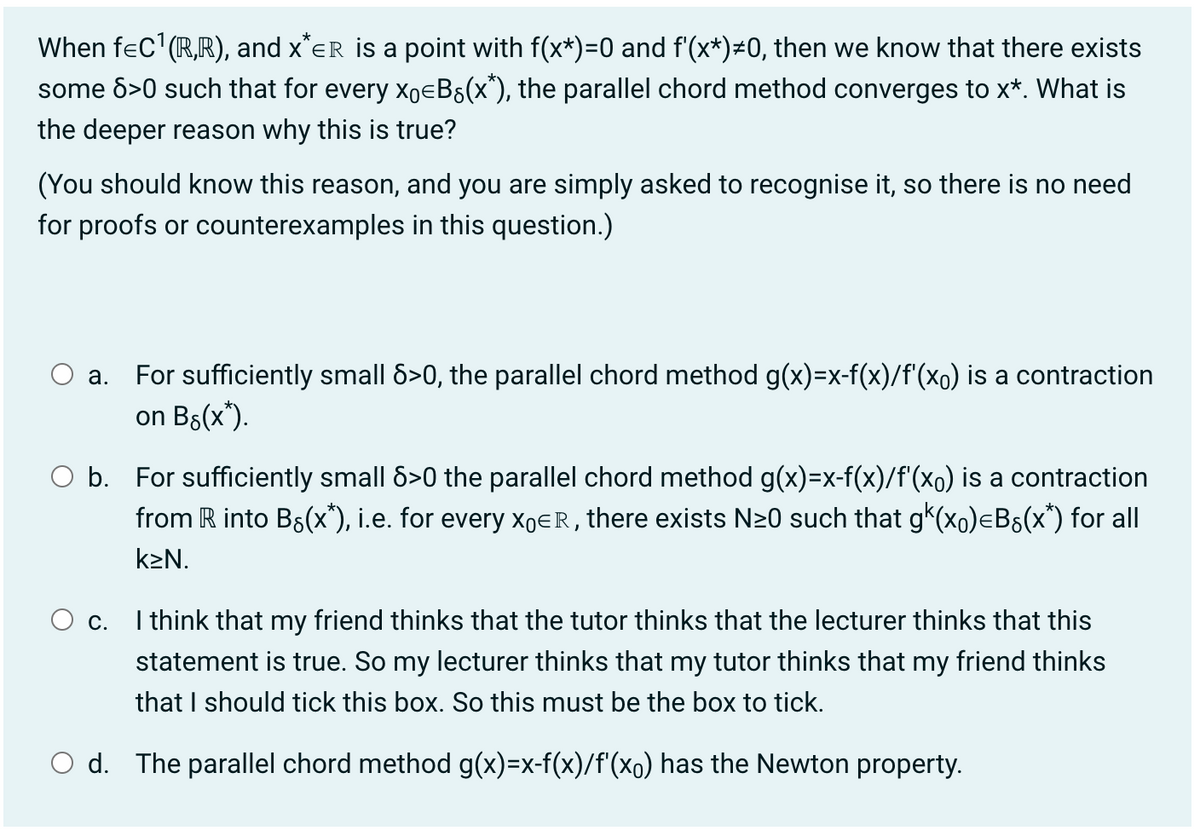When feC¹ (R,R), and X*ER is a point with f(x*)=0 and f'(x*) ±0, then we know that there exists some 8>0 such that for every x₁=BS(x*), the parallel chord method converges to x*. What is the deeper reason why this is true? (You should know this reason, and you are simply asked to recognise it, so there is no need for proofs or counterexamples in this question.) a. For sufficiently small 8>0, the parallel chord method g(x)=x-f(x)/f'(x) is a contraction on B8(x*). b. For sufficiently small 8>0 the parallel chord method g(x)=x-f(x)/f'(xò) is a contraction from R into Bg(x*), i.e. for every XÃER, there exists N≥0 such that g(x)=Bg(x*) for all k≥N. C. I think that my friend thinks that the tutor thinks that the lecturer thinks that this statement is true. So my lecturer thinks that my tutor thinks that my friend thinks that I should tick this box. So this must be the box to tick. d. The parallel chord method g(x)=x-f(x)/f'(x) has the Newton property.
When feC¹ (R,R), and X*ER is a point with f(x*)=0 and f'(x*) ±0, then we know that there exists some 8>0 such that for every x₁=BS(x*), the parallel chord method converges to x*. What is the deeper reason why this is true? (You should know this reason, and you are simply asked to recognise it, so there is no need for proofs or counterexamples in this question.) a. For sufficiently small 8>0, the parallel chord method g(x)=x-f(x)/f'(x) is a contraction on B8(x*). b. For sufficiently small 8>0 the parallel chord method g(x)=x-f(x)/f'(xò) is a contraction from R into Bg(x*), i.e. for every XÃER, there exists N≥0 such that g(x)=Bg(x*) for all k≥N. C. I think that my friend thinks that the tutor thinks that the lecturer thinks that this statement is true. So my lecturer thinks that my tutor thinks that my friend thinks that I should tick this box. So this must be the box to tick. d. The parallel chord method g(x)=x-f(x)/f'(x) has the Newton property.
Algebra & Trigonometry with Analytic Geometry
13th Edition
ISBN:9781133382119
Author:Swokowski
Publisher:Swokowski
Chapter10: Sequences, Series, And Probability
Section10.6: Permutations
Problem 47E
Related questions
Question
100%
Need help with this question. Thank you :)

Transcribed Image Text:When f=C¹ (R,R), and X*ER is a point with f(x*)=0 and f'(x*) ±0, then we know that there exists
some 8>0 such that for every xBg(x*), the parallel chord method converges to x*. What is
the deeper reason why this is true?
(You should know this reason, and you are simply asked to recognise it, so there is no need
for proofs or counterexamples in this question.)
a. For sufficiently small 8>0, the parallel chord method g(x)=x-f(x)/f'(x。) is a contraction
on B8(x*).
O b. For sufficiently small 8>0 the parallel chord method g(x)=x-f(x)/f'(x。) is a contraction
from R into Bg(x*), i.e. for every XER, there exists N≥0 such that g(x)=Bs(x*) for all
k₂N.
O c.
I think that my friend thinks that the tutor thinks that the lecturer thinks that this
statement is true. So my lecturer thinks that my tutor thinks that my friend thinks
that I should tick this box. So this must be the box to tick.
Od. The parallel chord method g(x)=x-f(x)/f'(x。) has the Newton property.
Expert Solution
This question has been solved!
Explore an expertly crafted, step-by-step solution for a thorough understanding of key concepts.
Step by step
Solved in 2 steps

Recommended textbooks for you

Algebra & Trigonometry with Analytic Geometry
Algebra
ISBN:
9781133382119
Author:
Swokowski
Publisher:
Cengage


Algebra & Trigonometry with Analytic Geometry
Algebra
ISBN:
9781133382119
Author:
Swokowski
Publisher:
Cengage
